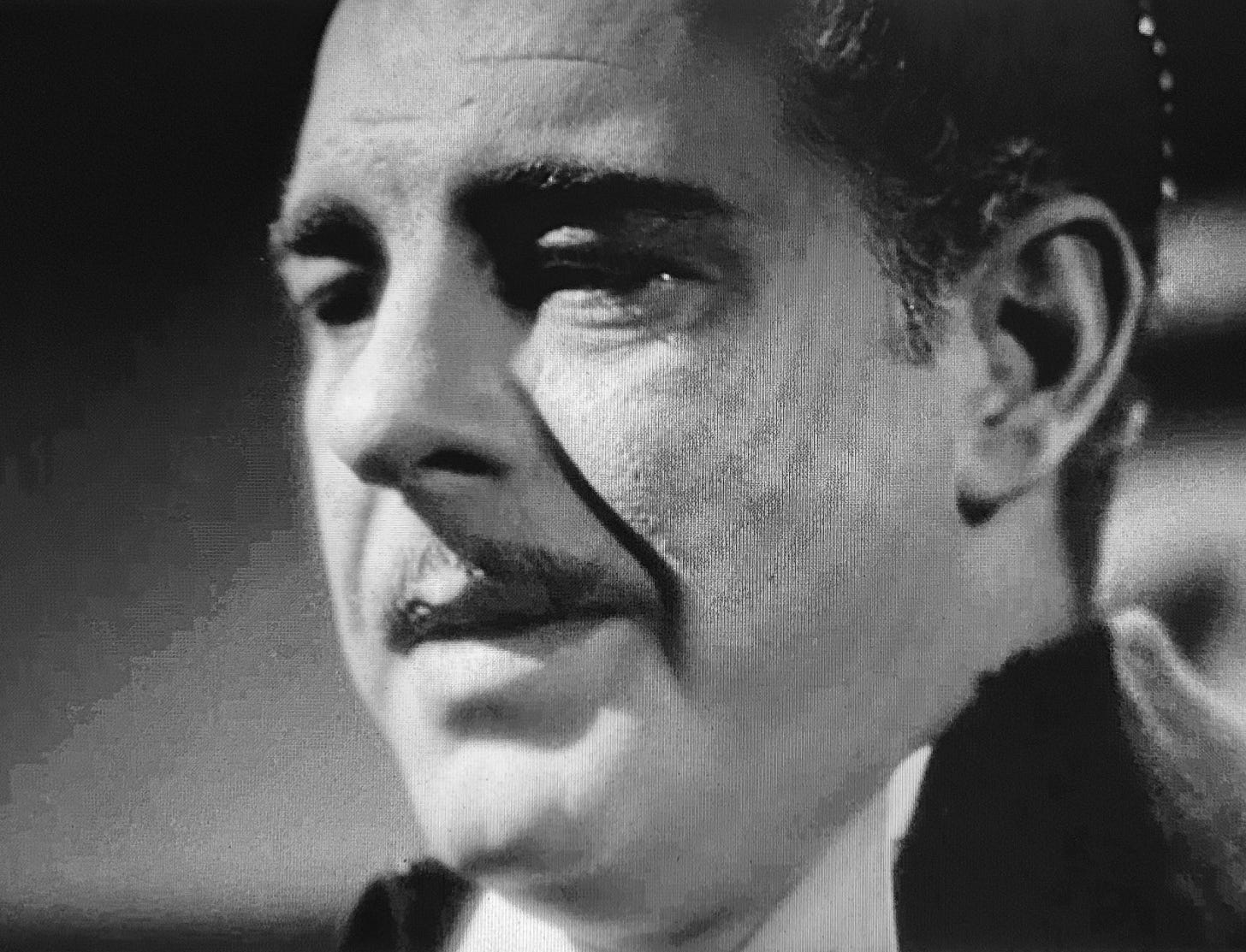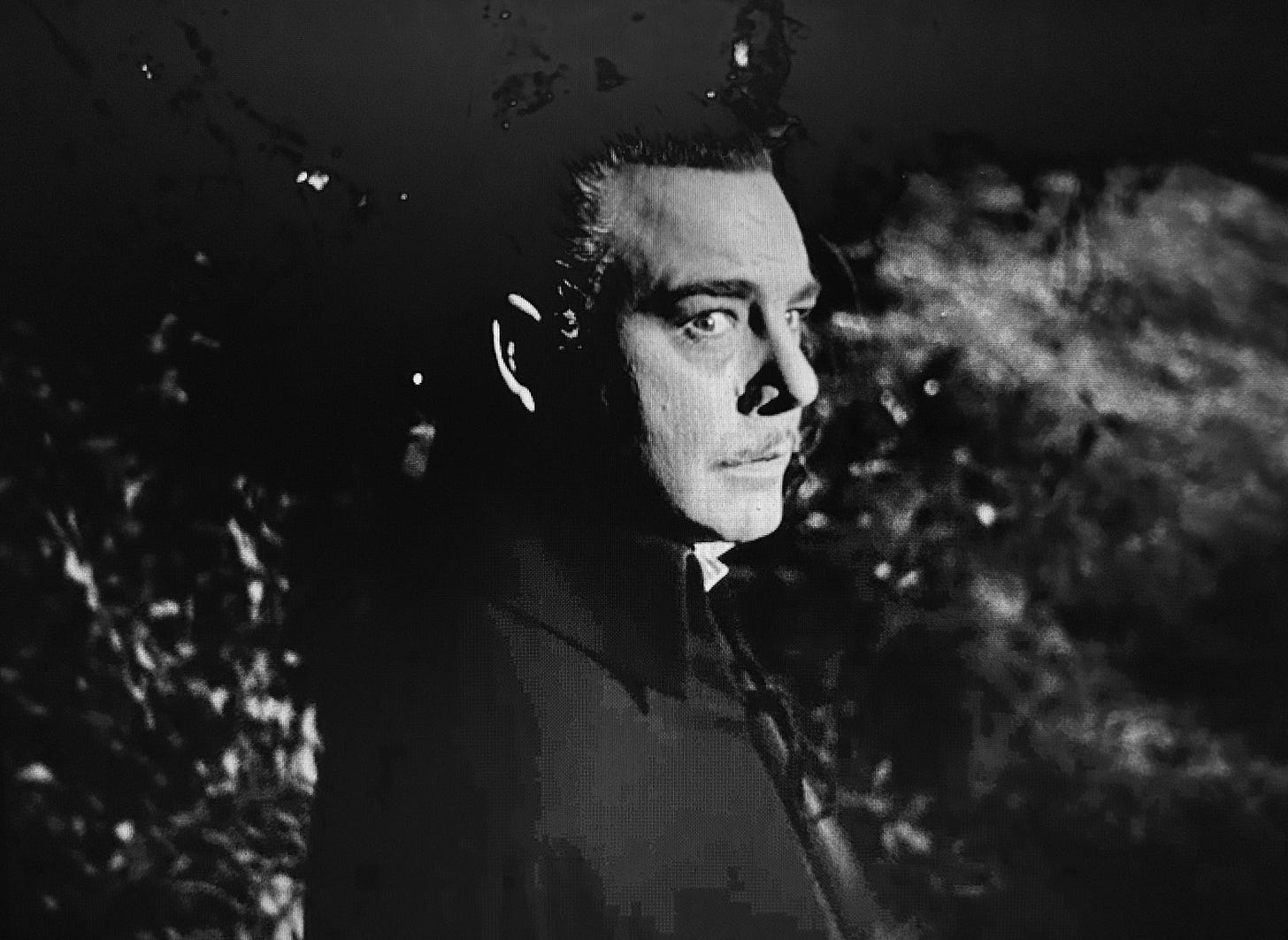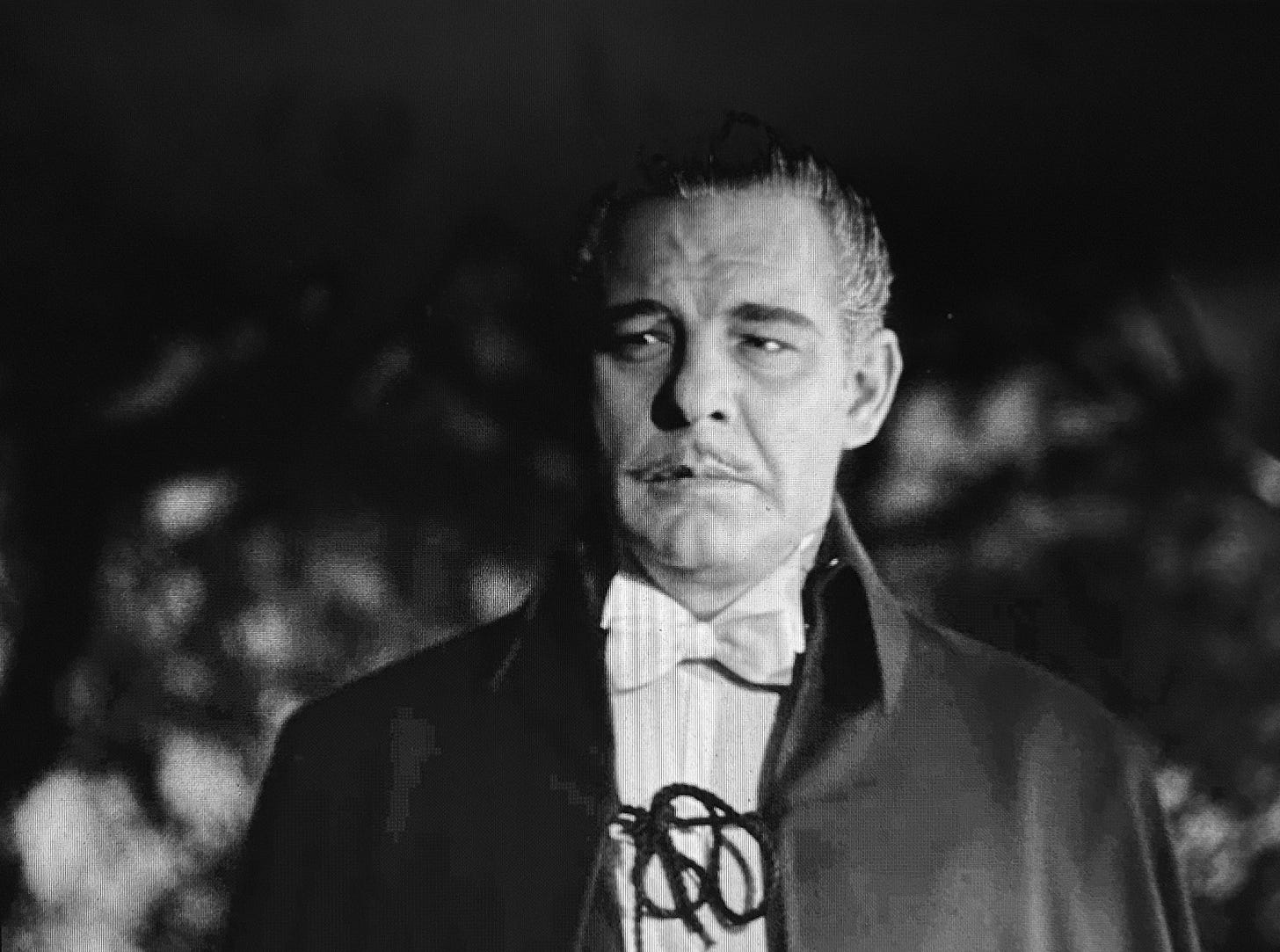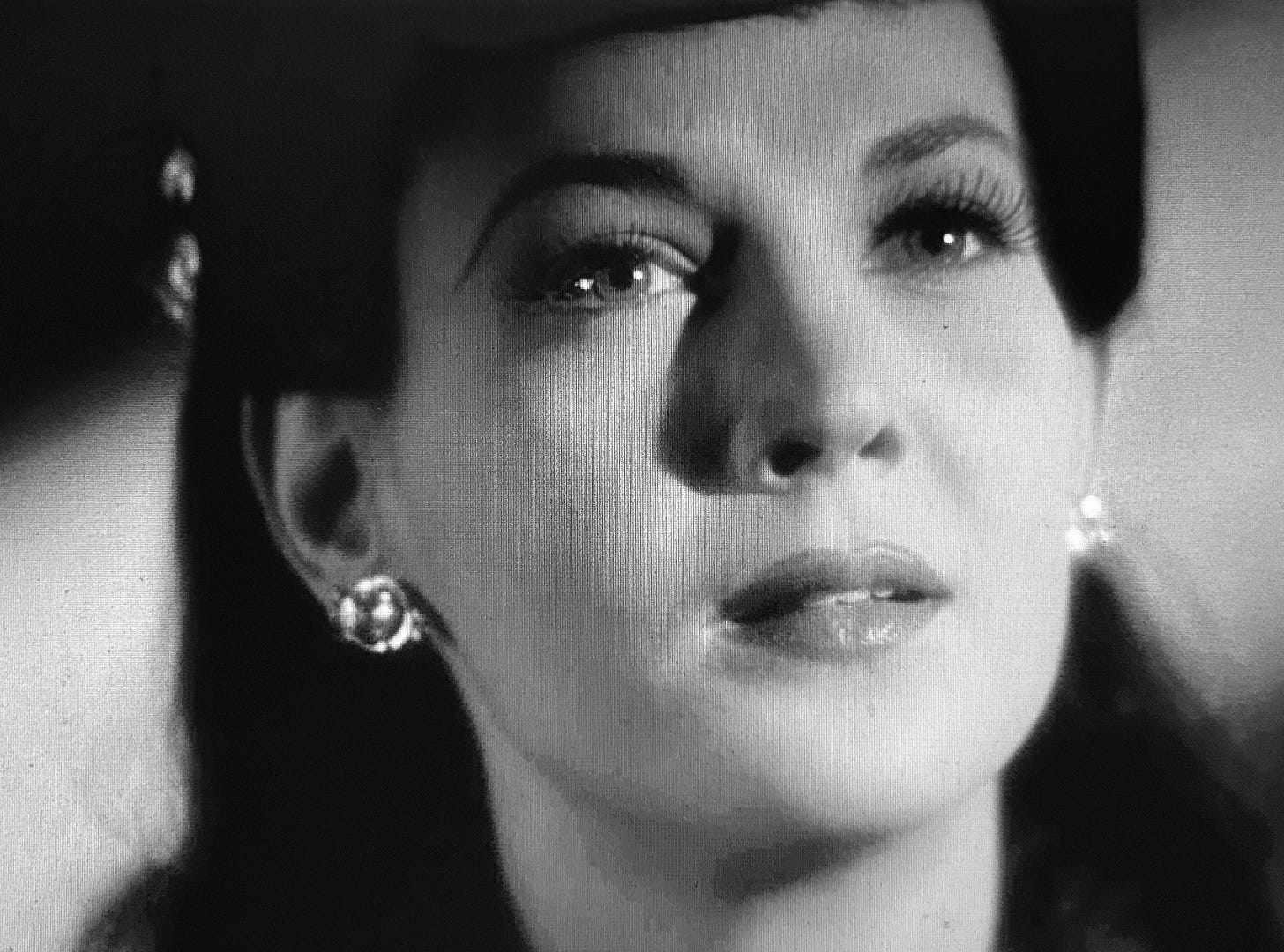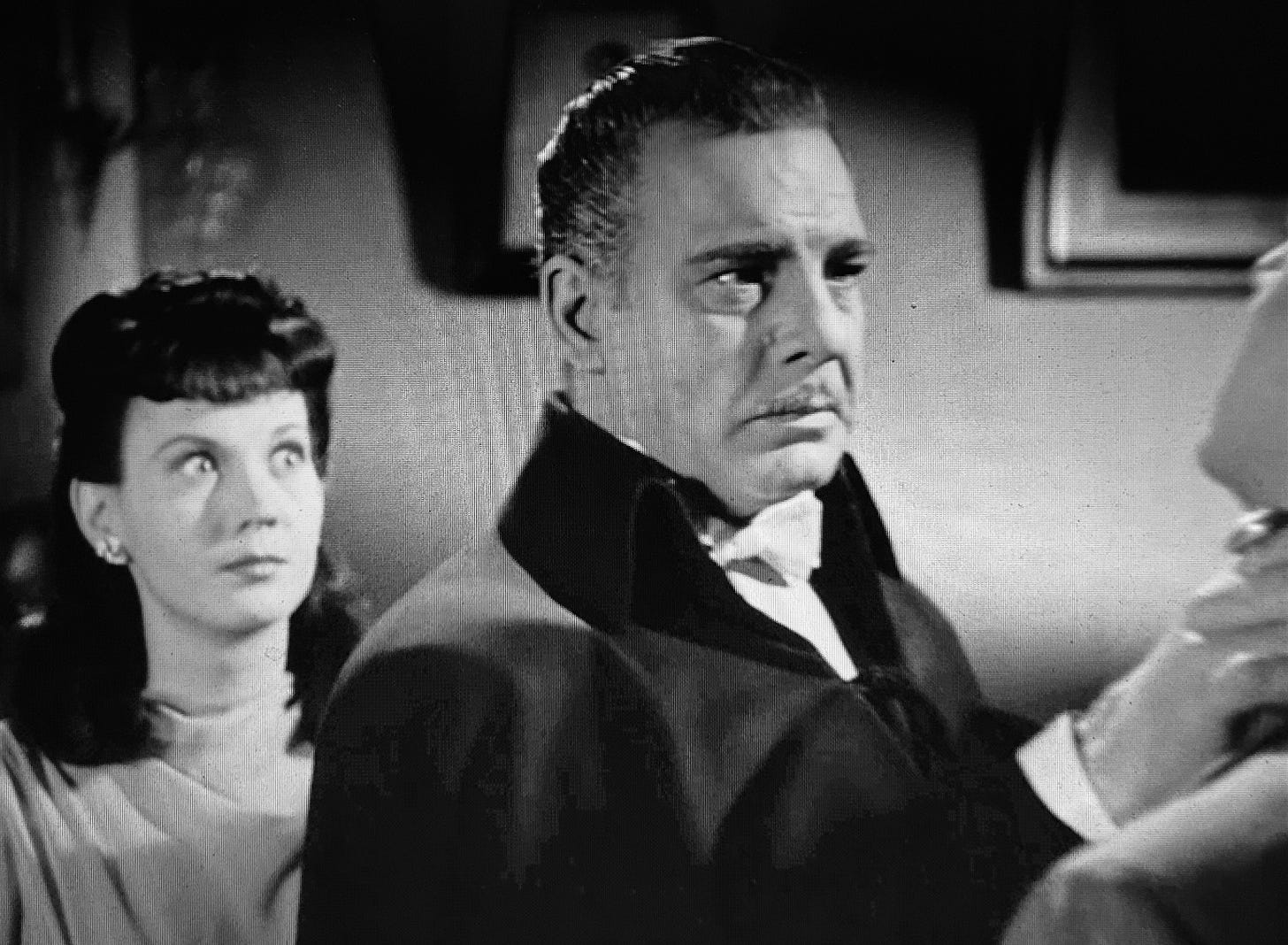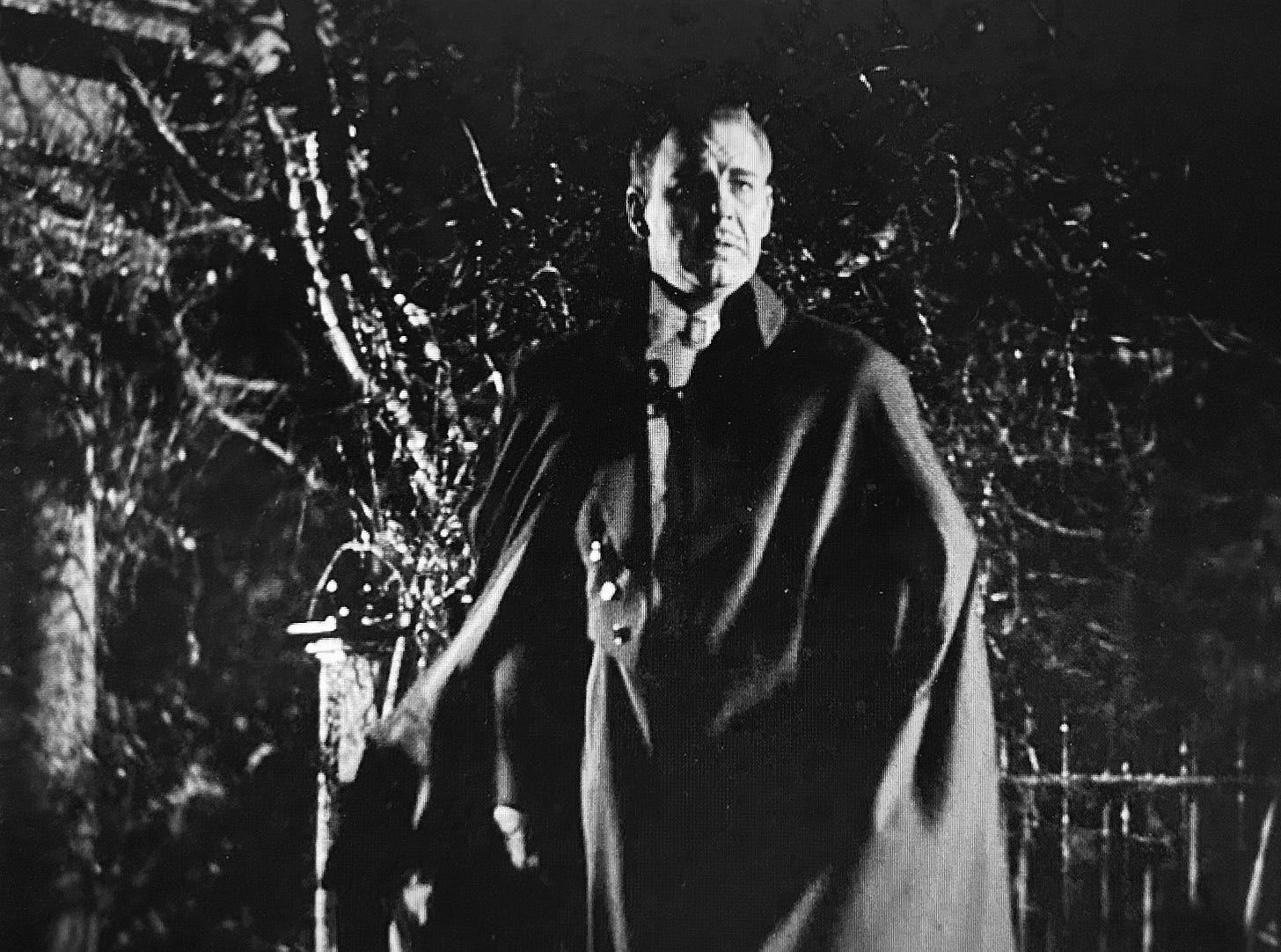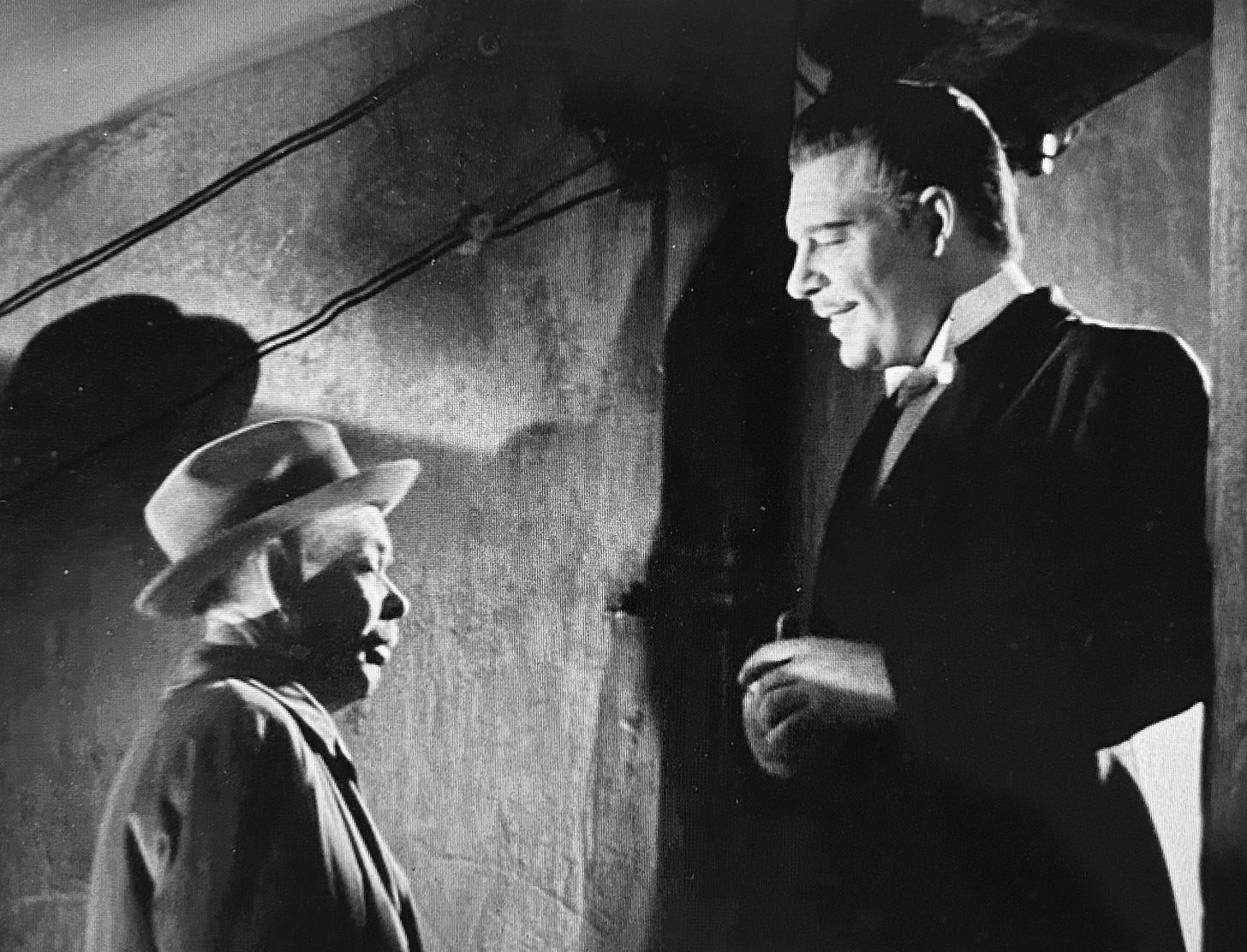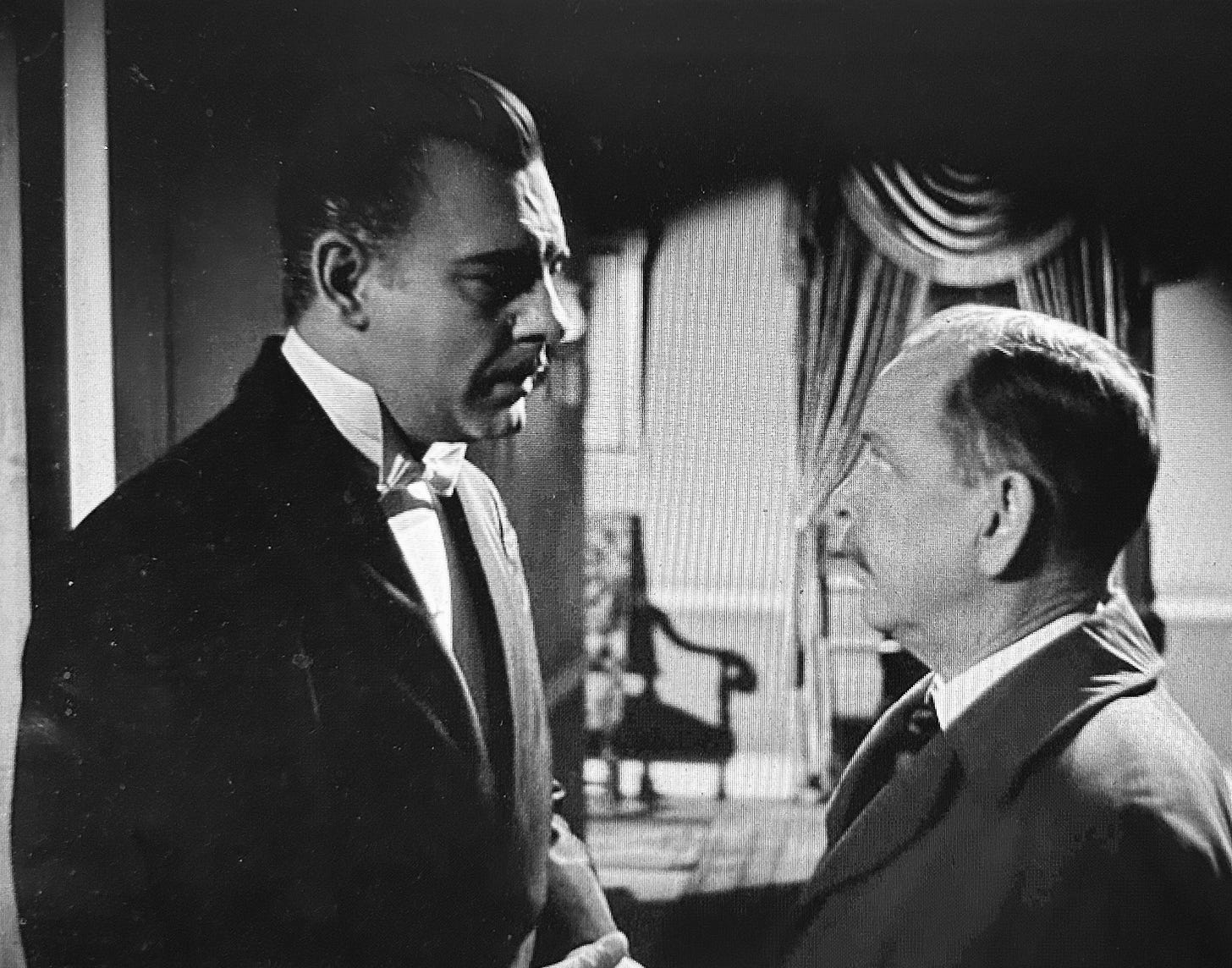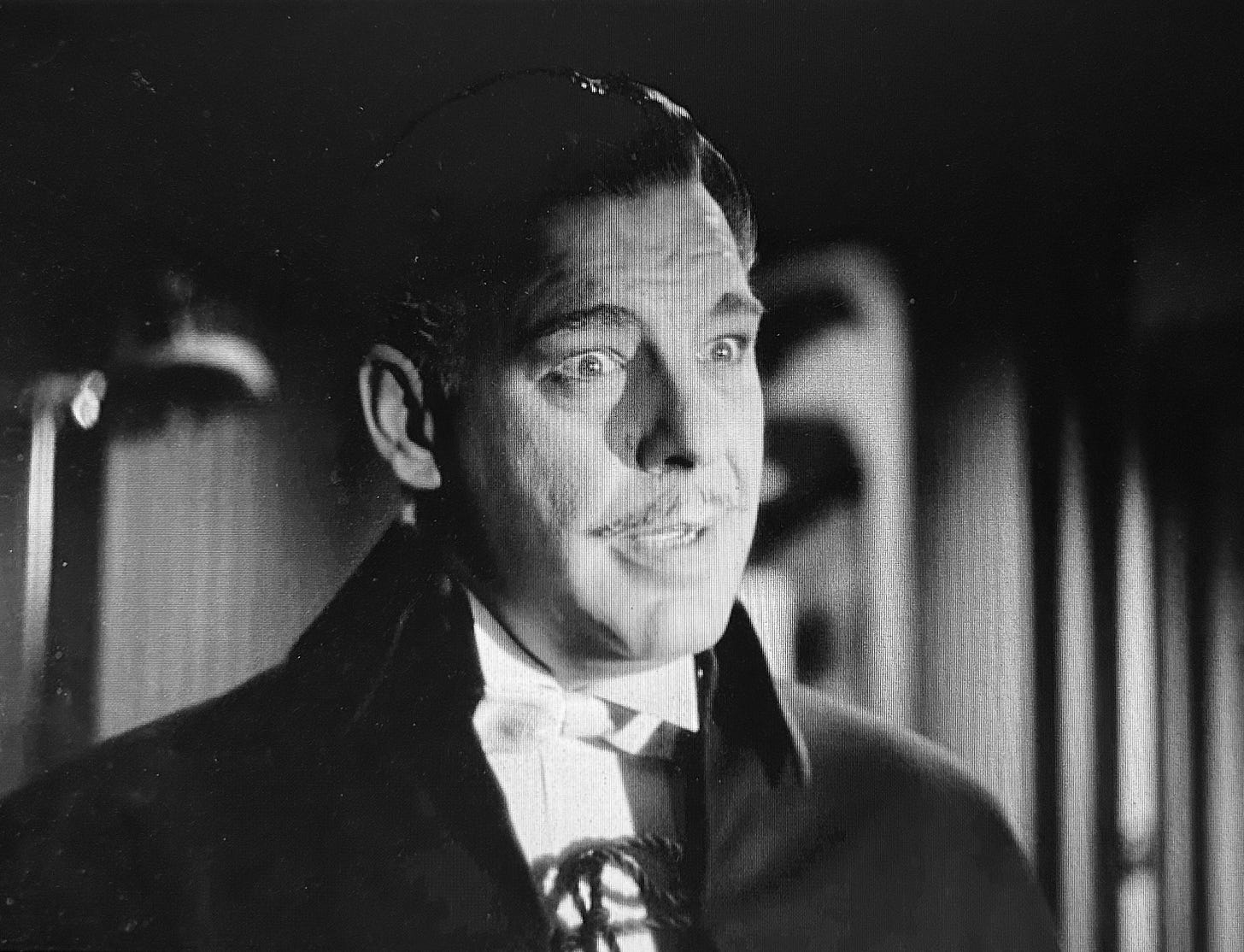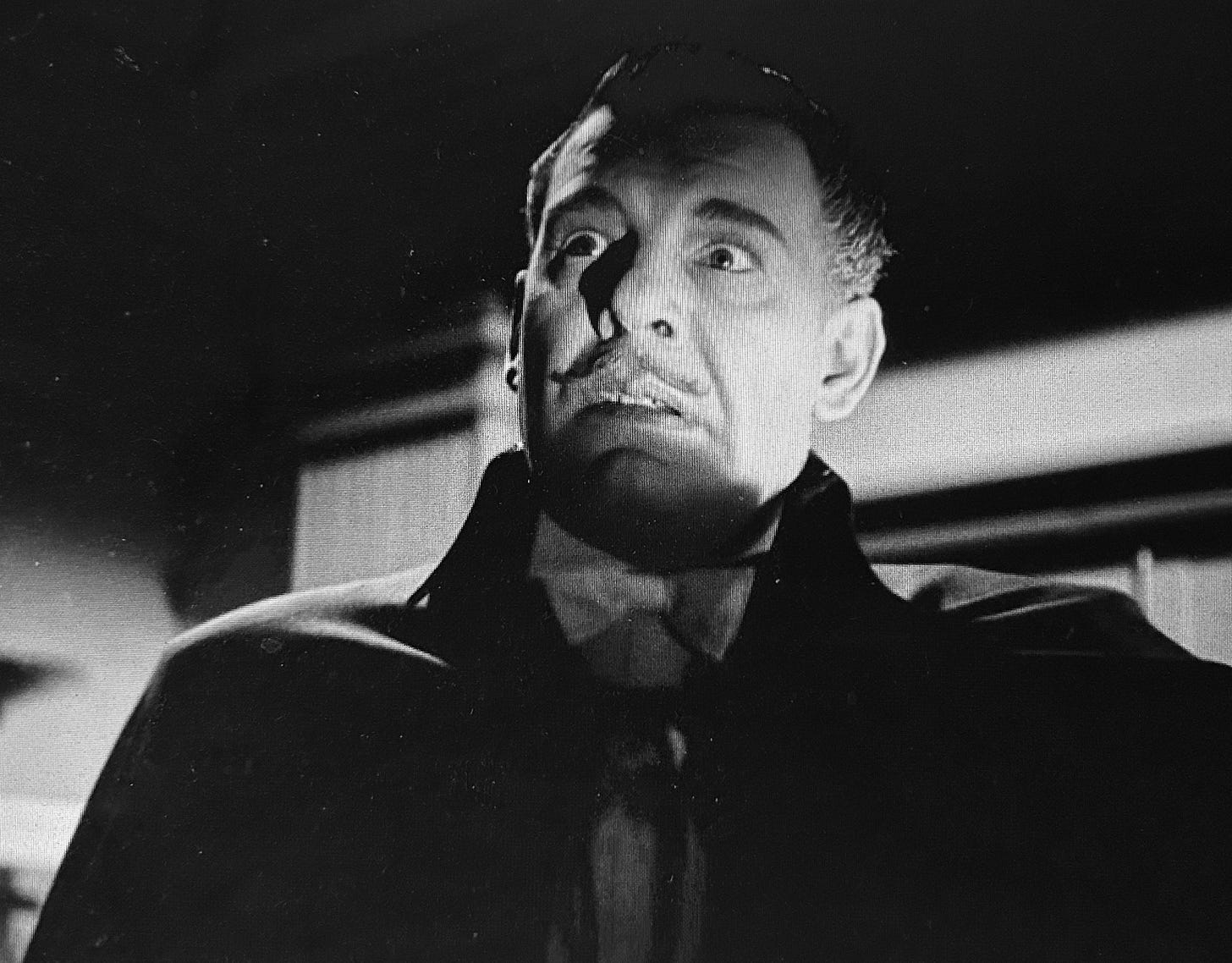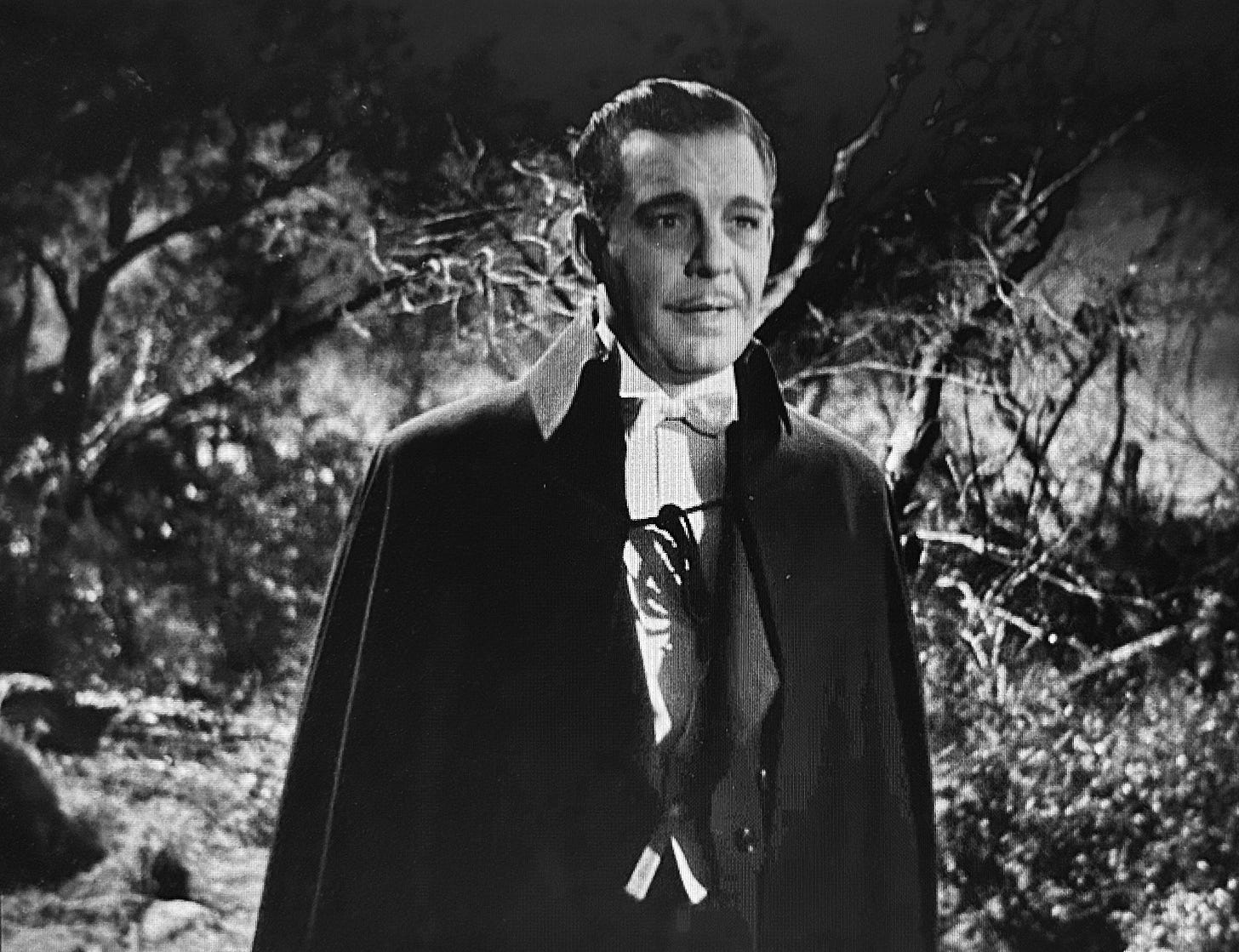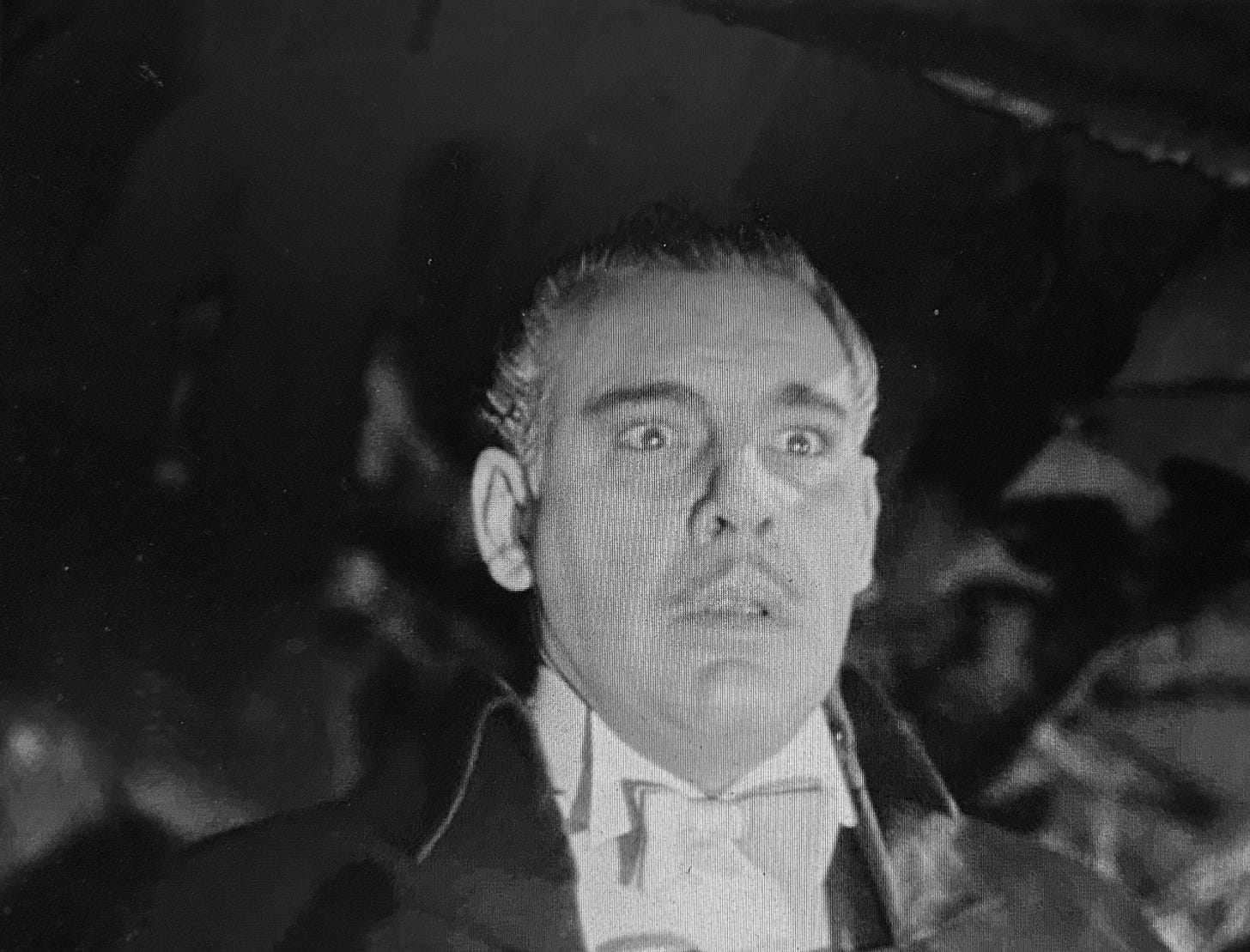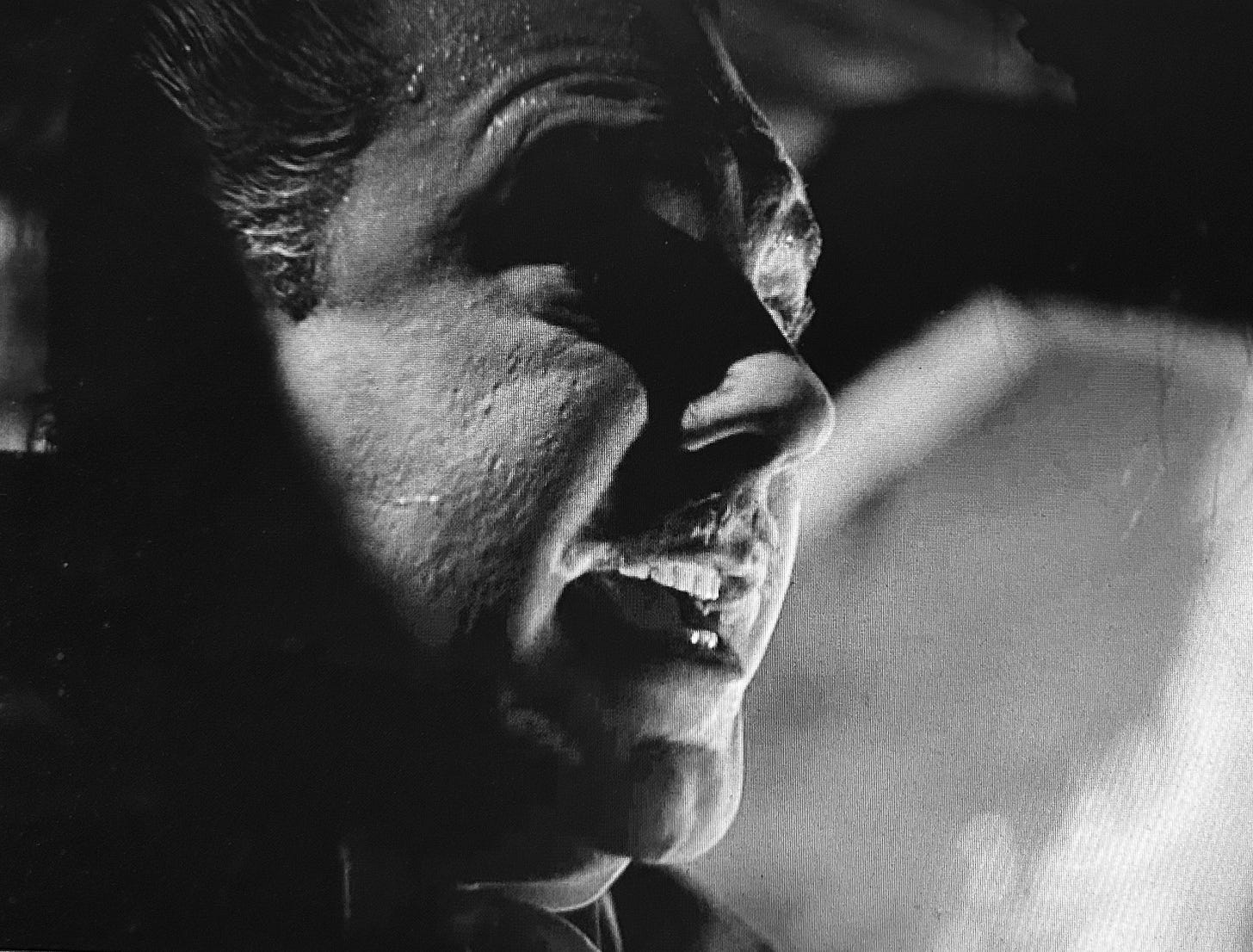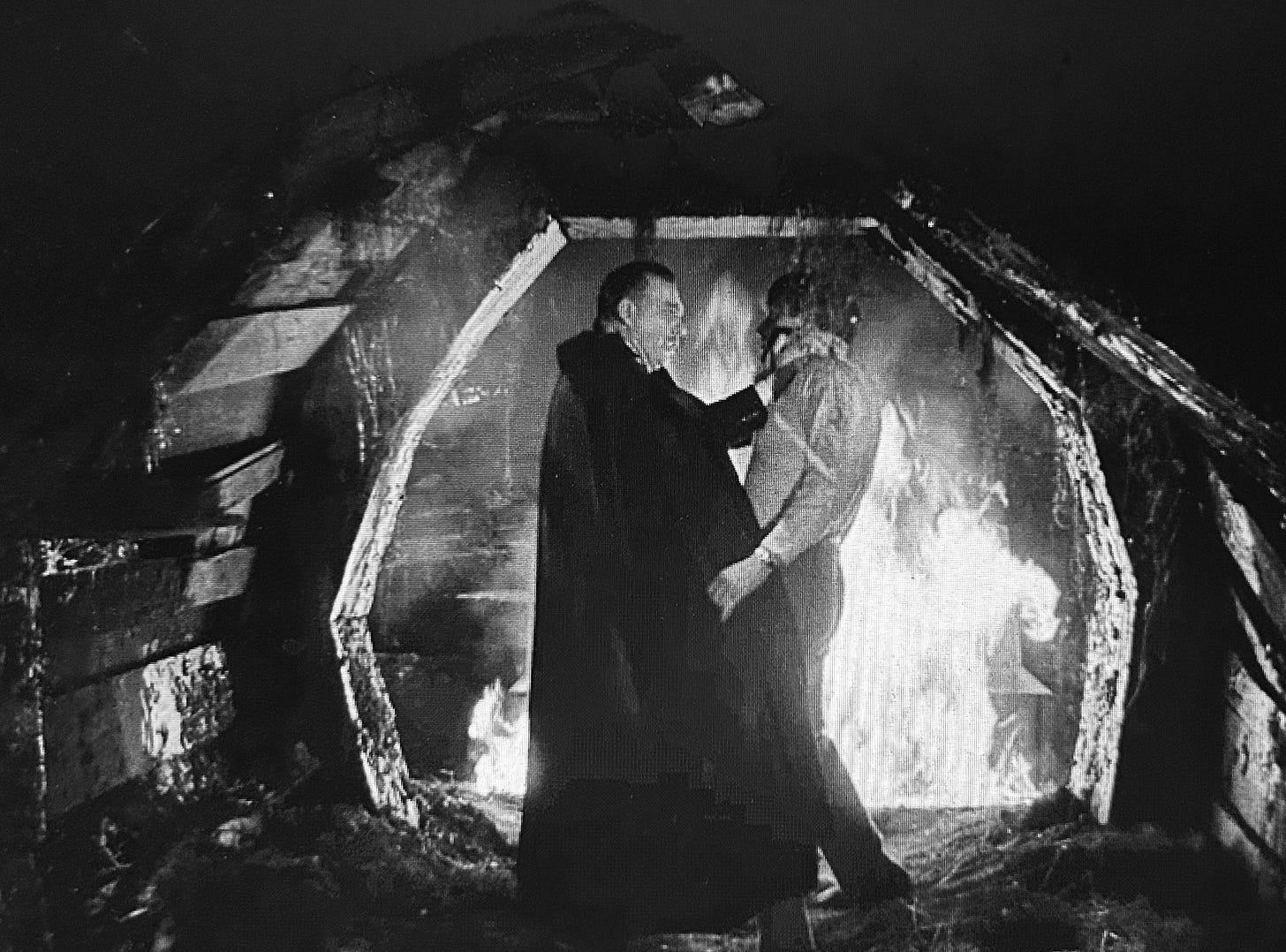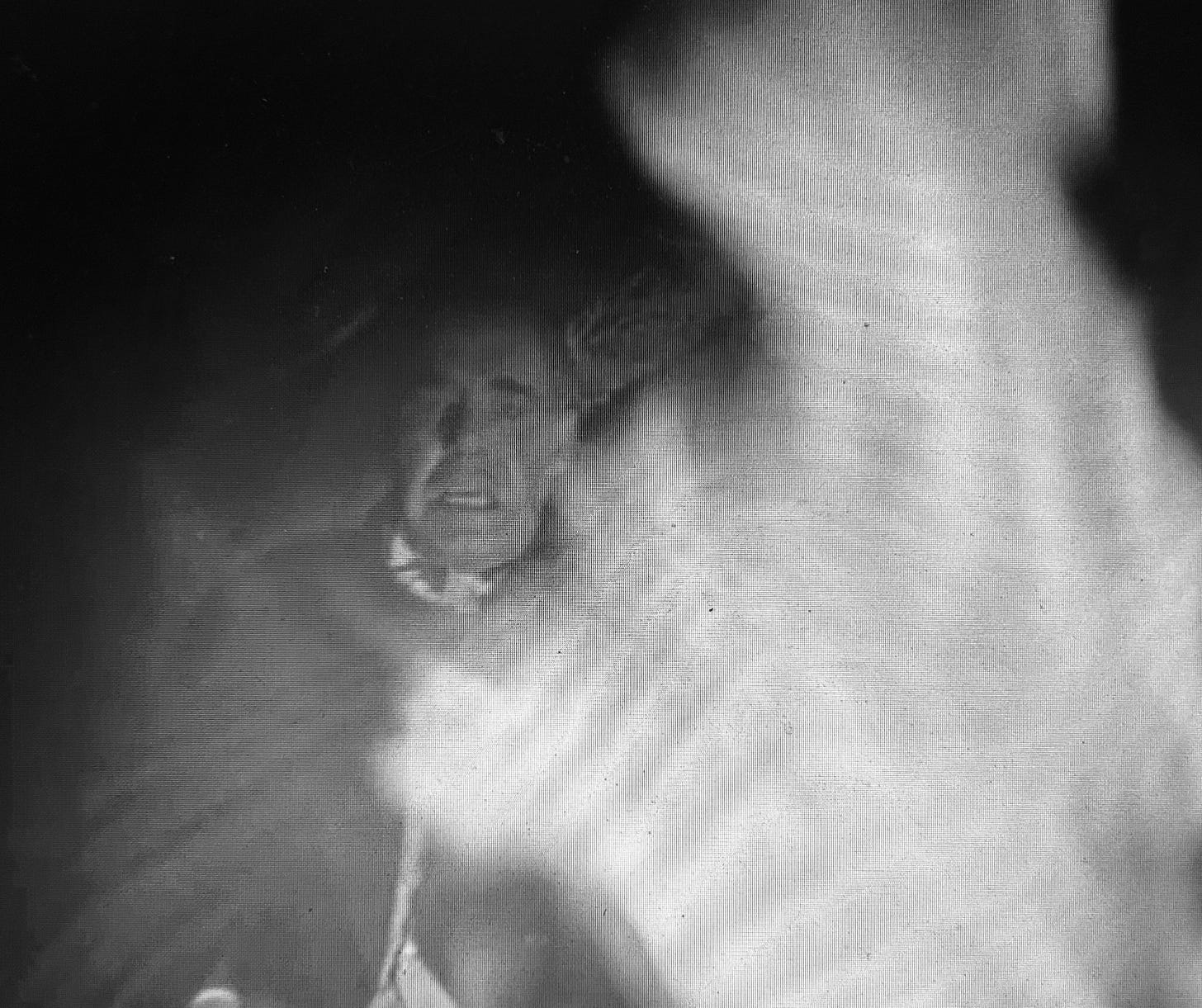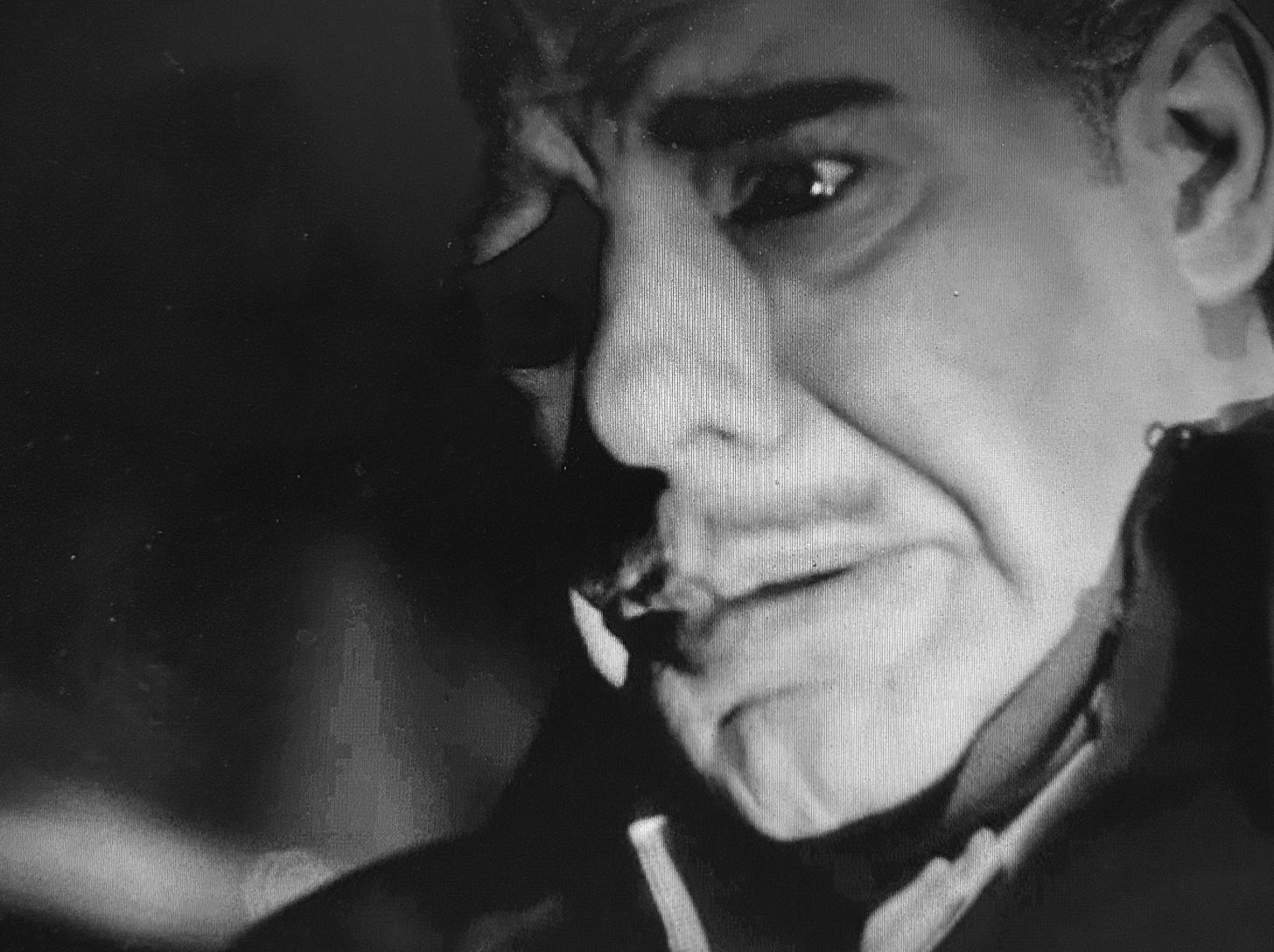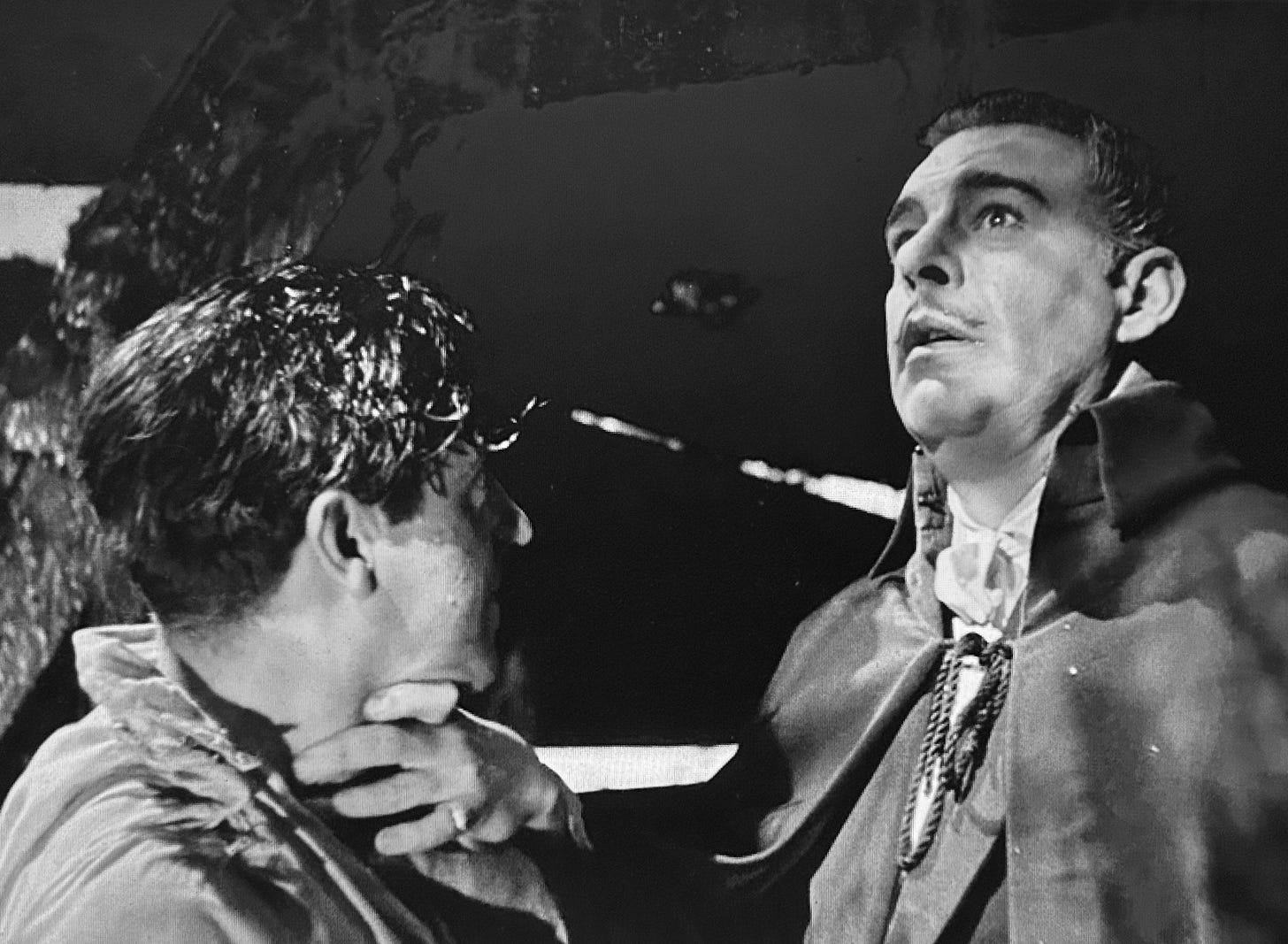CLASSIC HORROR BEHIND THE SCENES: IN DEFENSE OF LON CHANEY, JR. IN "SON OF DRACULA"
Very few Classic Horror films divide Monster Kids the way Robert Siodmak’s 1943 thriller has managed to over the years. But is Lon Chaney, Jr. as bad as detractors would have us believe?
By Bill Fleck, author of the Rondo-nominated book CHANEY’S BABY (available here), and the brand-new CHANEY’S AUDITION (available here).
Did you know? Two-time Rondo-Award winning filmmaker Thomas Hamilton is in the process of making VINCENT PRICE & THE ART OF LIVING. (I’m lucky enough to be a producer on the project—get info here). Check out Tom’s latest HORROR ICONS update—featuring interview clips with Jessica Rains, Elizabeth Shepherd, and Yours Truly—by clicking here. For information about possibly joining the Ignition Group and helping to get HORROR ICONS produced, click here. Thanks!
Check out other articles on this Rondo-nominated blog by clicking here.
Note: It is assumed that readers of this blog have seen SON OF DRACULA.
Regular readers of this website know that I spend far too much time reading—and commenting on—the social media pages dedicated to Classic Horror films. But sometimes, I strike gold when it dawns on me that the discussions I’ve become involved in can actually be the inspiration for an upcoming blog entry.
Such is the case this month. The subject?
Lon Chaney, Jr. in SON OF DRACULA (1943).
To paraphrase Forry Ackerman (when discussing the 1976 remake of KING KONG), half of my readers will applaud wildly; the other half may want to cancel their subscriptions to this blog at once. (But please don’t…we agree upon many more things Classic Horror than we disagree about, and it would be a shame to let this one film destroy all we’ve built together.)
Though discussions of the film online can be intriguingly nuanced, the general breakdown of opinion—at least as I read it—is as follows:
1. SON OF DRACULA is an absolutely excellent movie that influenced later film noir classics, such as THE KILLERS (1946). And Lon Chaney (Jr.)—though a bit too fat for the part—is excellent in it, being an effective precursor to Christopher Lee’s violently physical Dracula in the late 1950s and 1960s.
2. SON OF DRACULA is a good film. But Chaney—who tries hard—doesn’t quite nail it. (And, by the way, he’s too fat to play a vampire.)
3. SON OF DRACULA is okay, but Chaney is terrible. Universal needed to bring back Bela Lugosi. (And, by the way, Chaney’s too fat to play a vampire.)
4. SON OF DRACULA is just silly. And Chaney is terrible. Universal needed to bring back Bela Lugosi. (And, by the way, Chaney’s too fat to play a vampire.)
And so…that said…where do I fall?
Well, I’m mostly in sync with opinion number 1.
Wait—wait! Please don’t scroll away! I’d love a chance to make my case…
Still here? Thank you for that! Because of your willingness to engage, I’ll cut to the chase and deal with the elephant in the room…
[Above: A screen shot of Chaney’s first appearance as Dracula in the movie. The filmmakers boldly had Chaney break the fourth wall, as if to say—as the BORGO PASS HORROR PODCAST puts it—“I’m Dracula; deal with it.”]
CHANEY AS DRACULA
(The elephant in the room…see what I did there?)
Most Monster Kids celebrate Robert Siodmak’s direction of SON OF DRACULA. Many celebrate Curt Siodmak’s story—and Eric Taylor’s screenplay—as an early example of film noir, enhanced by a horror setting (even if there are some plot holes). The re-recorded, re-used musical score from previous Universal films doesn’t seem to grate on most viewers, and the production itself—sets, camerawork, editing, etc.—generally rate high marks.
So, for many, the film sinks or swims on Lon Chaney, Jr. (Have I mentioned that many Monster Kids believe that Chaney was too fat to play a vampire?)
Let me state my feelings regarding Chaney’s size straight away.
I subscribe to writer Bruce Dettman’s opinion regarding the issue in SON OF DRACULA: “[I]s there some rule that says a vampire must be skinny?”
I don’t believe that there is. And Universal certainly didn’t think so. As such, the studio went to great pains to emphasize—even exaggerate—Chaney’s bulk in publicity materials for the film:
“Only a giant of Chaney’s proportions—six feet, three and one-half inches, and weighing 220 pounds—could have absorbed the physical punishment his ‘horror’ assignments have entailed,” they claimed. [1]
True, previous Classic Horror screen vampires—the spidery Count Orlock in NOSFERATU (1922), Lon Chaney, Sr.’s faux neck-nibbler in LONDON AFTER MIDNIGHT (1927), and the wispy Marguerite Chopin in VAMPYR (1932) come to mind—aren’t heavyweights by any means. But Bela Lugosi in DRACULA (1931)—at a billed height of 6’1” and weighing at least 175 pounds—isn’t skinny by any stretch of the imagination.
And don’t forget…in SON OF DRACULA, we’re dealing with fantasy. After all, we’re expected to believe that the vampire defies physics by transforming into a cloud of mist…or a bat roughly one-eighth of Chaney’s mass.
So, if Chaney is coming in at 40 more (mostly muscular) pounds than Lugosi, I’m cool with it, especially given the more physical Dracula Taylor’s screenplay has him playing…a character that Dettman and other scholars have correctly identified as a precursor to Christopher Lee’s later, more violent take on the Vampire King.
The result? With his grayed temples, clipped mustache, pale complexion, cold eyes, and undeniable physical presence, Chaney is a Dracula to be reckoned with. Being, well, BIG helps to sell that.
“I like a Dracula who can kick ass!” film scholar Tom Weaver once exclaimed.
[Above: Dracula rudely demands entry into the Caldwell’s mansion. Chaney’s version of the character is brazen, brutish, unsophisticated, and decidedly not Lugosi. But does that make it bad?]
“Okay, Fleck,” skeptics might say, “maybe—just maybe—I can get over the size thing. But what about Chaney’s lack of a European accent?”
The first—and simplest—response to that is…no one connected with the making of the film likely cared. And filmgoers in general didn’t seem to, either.
Let’s face it—SON OF DRACULA was made at a time before Stanislavsky became truly influential in movie acting.
Go with me on this.
Remember Fredric March’s stunning English accent in DR. JEKYLL AND MR. HYDE (1931)—you know, the film that got him his first Oscar? Of course you don’t…because there wasn’t one.
How about Clark Gable’s spot-on English accent in his Oscar-nominated portrayal of Fletcher Christian in MUTINY ON THE BOUNTY (1935)? Or Claude Rains’ perfect French accent for his Oscar-nominated role in CASABLANCA (1942)?
Well…no. On both counts.
You get the idea.
Hey, in the earlier years of sound movies, unless your name was Paul Muni—Chaney’s favorite actor, by the way—or Laird Cregar, you really weren’t all that concerned about nailing down accents.
And in SON OF DRACULA, it’s not only Chaney who performs sans accent. Remember, the film takes place in Louisiana, deep in the American south…but how many southern accents do we hear? Frank Craven as Dr. Brewster? No. Samuel S. Hinds as Judge Simmons? No again. Evelyn Ankers as Southern belle Claire Caldwell and/or Robert Paige as Frank Stanley, native-born with a silver spoon in his mouth? No, and no. Patrick Moriarity as Sheriff Dawes? Yeah, no.
And how about the excellent portrayal of the villainous Katherine Caldwell by Louise Allbritton?
Excellent it is. But she uses no southern accent.
In fact, aside from J. Edward Bromberg as Professor Lazlo (who tries to sound as if he’s from Hungary), the only other actors with accents are the guys who portray the stereotypical (now offensively so) servants at Dark Oaks.
[Above: Perhaps the film’s most famous scene. Dracula glides across the swamp toward Katherine Caldwell, his intended bride.]
Given these facts, I think it’s a bit unfair to single out Chaney. I highly doubt that director Siodmak went around pulling out what was left of his hair because he couldn’t get Chaney to try to sound like Lugosi. No one else in authority connected with the making of the movie likely cared, either. (I mean, have you read about producer Ford Beebe?) [2]
However, if you prefer in-context answers to issues like these—and who doesn’t?—you might want to follow me down a rabbit hole for a second possibility…
To consider this one, we’ll need to go back to Bram Stoker’s DRACULA.
No, not the Coppola film with Gary Oldman (which, in my view, really isn’t Bram Stoker’s anyway…but that’s a story for another day). No, I’m talking about the 1897 novel.
One of the interesting things about the Count in that classic tome is his desire to master the English language. Why?
“Well I would know,” Dracula tells Jonathan Harker, “that did I move and speak in your London, none there are who would not know me for a stranger. That is not enough for me. Here I am noble; I am boyar; the common people know me, and I am master. But a stranger in a strange land, he is no one; men know him not—and to not know is to care not for. I am content if I am like the rest, so that no man stops if he see me, or pause in his speaking if he hear my words, to say ‘Ha, ha! A stranger!’ I have been so long master that I would be master still—or at least that none other should be master of me.”
In other words, to achieve his ends in his new home, Dracula intends to blend in. And in order to do that, he needs to speak English like a native, lest he arouse suspicion.
“Dracula’s attempt to learn vernacular English proves his intention to place himself in a public relationship, which although it is predatory is also communicative…” scholar Maria Parrino notes. “Dracula does not want to be singled out as a ‘stranger’—by which he means a foreigner—and wishes instead to be ‘like the rest.’ Like the rest, in the London whirl of humanity, he might engage in a conversation with native speakers, he might become not only visible but audible. In that case, his pronunciation will reveal the foreigner, the alien, the one who does not belong. In order for that not to happen, the vampire develops an ambitious and obsessive aim to equip himself with the correct English spoken language, convinced that such a skill will ‘let him in’ [emphasis mine].”
One could argue that Chaney’s version of Dracula attempts to work the same plan.
Am I reading too much into this? Of course I am! Again, the first explanation is far more likely. But the second—though not intended, I’m sure, by the film’s creators—is prominent enough to provide careful viewers with some interesting subtext.
[Above: Katherine and ‘Alucard’ on their wedding night. The sexually-charged close-ups leave little doubt about what each is thinking as the fatal bite is about to be delivered…]
“IF CHANEY WAS PORTRAYING A VAMPIRE NOT NAMED DRACULA, WOULD YOU STILL HAVE A PROBLEM WITH HIM?”
It’s a question I’ve asked from time to time in monster groups on social media.
The Number 1 reply?
“But he is.”
Okay, agreed. Now, let’s fall back a minute and deal with the phrase I found myself typing a few paragraphs ago: “Chaney’s version of Dracula.”
This begs the question, “Who, exactly, is Chaney playing?”
Ready to run roughshod once more over some much-traveled—but still rugged—terrain? Okay. Here we go….
The film is called SON OF DRACULA. Yet Chaney is billed as COUNT DRACULA.
Hey, the son of a count who is a count himself is addressed as “Count So-and-So,” correct? After all, the son holds the title in his own right. So, I don’t have any issue believing that this Count Dracula is some sort of descendant—or “son”—of the Dracula family that has terrorized their fiefdom for much of its existence.
“In Transylvania,” Professor Lazlo reiterates, “the name is associated only with evil…”
But…is Chaney playing the same Count Dracula as Bela Lugosi, who traveled from the broken battlements of his castle in Transylvania to London, England, in about 1930? And was staked to death in Carfax Abbey? [3]
The answer is obviously no.
“History says the last Count Dracula died in the middle ages…” Lazlo confidently tells Dr. Brewster. “According to the legends of my people, the last Count Dracula became one of the undead—a vampire—and was finally destroyed in the 19th century.”
In other words, the “historical” Dracula has been dead since the 1800s. So, if a Count Dracula had indeed wreaked havoc in London and Whitby roughly thirteen years previous, Professor Lazlo—“considered somewhat of an authority on the subject”—is totally oblivious.
As such, SON OF DRACULA is operating in what we might call today “an alternative Universe,” with Chaney playing, well, a “version” of Dracula we haven’t seen before…a version who was buried in Hungary, is “undoubtedly a vampire, probably a descendant of Count Dracula,” uses an undeniably stupid alias, and is intent upon draining America dry, “just as he did his homeland” in the Carpathian hills.
Little wonder the script has Alucard—in his final moments, as his coffin burns—“crazily” screaming at Frank:
“You would destroy a Dracula?”
A Dracula…
So…while Chaney is playing a descendant of the infamous family, he is not playing the Lugosi version, as is evidenced by his aforementioned ‘stache and graying hair. Therefore, in my mind at least, there was little-to-no reason for Chaney to try to imitate Lugosi’s bearing and mannerisms (not to mention his way of speaking and/or his accent). [4]
So, if Chaney’s Dracula is less polished, less sophisticated, and more outwardly brutal than Lugosi’s, what of it? It’s not the same character.
Honestly, if we divest ourselves of the idea of Bela in the role, we can enjoy Chaney that much more.
(Your opinion, of course, may vary. But please keep subscribing to this blog.)
[Above (top): Chaney’s Dracula possesses brute strength, a precursor to Christopher Lee’s more animalistic portrayal of the Vampire King (note Kay’s shocked stare). Above (bottom): Chaney’s eerie stare after Frank Stanley shoots him—to no effect—helps drive Frank into madness.]
WHAT HATH CHANEY WROUGHT?
Given all of the above, what might we say about Chaney’s performance if we try it on with new eyes? For the purposes of this blog, I’ve recently viewed the film once again. Let’s savor some of the moments…
Although we’ve already seen Dracula in bat form floating around Dark Oaks—and causing Queen Zimba to keel over from a fatal heart attack—we don’t get our first look at Chaney in the part until about 7:30 in…and what a “look” it is!
Coming at the tail-end of a clever dolly shot, we see a husky figure lurking in the dark, staring at unsuspecting revelers enjoying the dancing in the big house. And then, the figure turns his head, chillingly breaking the fourth wall with an evil glimmer in his eyes.
“It’s a challenge, almost,” notes Jim Towns and Livio Merino on their BORGO PASS HORROR PODCAST. “It’s like, ‘We’re here, we’re doing this—I’m Dracula; deal with it. We’re movin’ on.’”
“You don’t often see ‘breaking the fourth wall’ touches in horror oldies,” Tom Weaver writes, “but in a grotesque way, it works here.”
From there, Dracula turns into a bat—handled a bit clumsily by a jump-cut—and flaps quickly down the upstairs hallway. Once safely ensconced in what appears to be a spare room, he reverts to human form (via animation), and creeps into the master bedroom to take his latest victim. [5]
It’s at about 13:55 that we get Dracula’s first line:
“Announce Count Alucard,” he demands coldly after rudely knocking on the front door at Dark Oaks in the middle of the night and startling the butler. “Explain that I came by motor and was delayed.”
“I’m sorry, sir,” the polite butler tries, “but Colonel Caldwell died tonight, and the family isn’t receiving.”
‘Alucard’ isn’t having any of this.
“Announce me!” he commands…and his bidding is understandably done.
So far, so good…this is a formidable Dracula with an attitude, and Chaney has thus far embodied him perfectly.
[Above: Alucard is obviously miffed when the nosy Dr. Brewster does an unwelcome ‘wellness check’ on Katherine at Dark Oaks, where Alucard has just become master…]
Nearly ten minutes go by before we see him again, but it’s probably the most famous scene in the movie. Dracula’s coffin emerges from a swamp, belching thick mist that eventually dissolves into a commanding shot of Chaney. And then Dracula, well, glides across the water toward a waiting Kay and her car. [6]
True, the special effects folks—and the camera crew—are the stars in this moment. But the hint of a sardonic smile on Chaney’s face definitely helps sell the action.
Following a brief stop to the Justice of the Peace to legalize their unholy union, the newlyweds return to Dark Oaks…and engage in one of the most startlingly effective scenes in the Universal horror canon.
Monster Kids everywhere know that Alucard is about to put the bite on his wife when Frank barges in and confronts them. Frank gets summarily flung into the next room for his trouble, loses it, and attempts to shoot Alucard to death. Of course, the bullets pass through the vampire and rip into Kay, ostensibly killing her. [7]
The acting in this scene by all concerned is superb.
“As I have told you, my dear,” Chaney purrs to his bride, “ours will be a different life, without material needs. A life that will last through eternity.”
This effectively-delivered foreplay line is immediately followed by two stunning closeups of Kay and Dracula. And we don’t have to guess what’s on their minds!
Of course, Frank spoils the moment. He demands that Alucard leave town; Kay will have the marriage annulled. He threatens the Count—who glares at him in utter contempt—with jail.
In the next three seconds, Frank finds himself sprawled flat on the floor in the next room.
This is the power Chaney generates, the sense of animal violence that paves the way for Christopher Lee.
Frank’s ensuing attempted murder of Alucard is startling in its own right. At first dazed from the fall, his consciousness clears in time to register—with obvious incredulity—that his gun is worthless against the Count.
And thinking that he’s killed the love of his life doesn’t help…
But what really seems to put him over the edge into madness is a stare. The icy cold, knowing stare of a creature who has seen it all and knows he need only bide his time to exact revenge.
It’s a truly chilling Chaney moment.
[Above: Alucard greets—and dismisses—Dr. Brewster with barely-concealed contempt. Chaney’s icy delivery in these scenes is a highlight.]
We next see Dracula at approximately the 35-minute mark. He’s in the process of burying Katherine when Brewster shows up for an unannounced wellness check. Clearly aggravated—perhaps because he didn’t bother to lock the gates to the estate?—Dracula confronts Brewster, agrees to let him see Kay to confirm that she is, indeed, ‘alive,’ and—in a barely civil tone that fails to hide his contempt—informs the interloper, “Anyone who enters here without my permission will be considered trespasser.”
It’s icy-cold perfection on Chaney’s part, and he’s matched every step of the way by Allbritton and Craven.
Up next? At about 52 minutes in, a mist appears from under the door in Dr. Brewster’s office while he and Lazlo discuss exactly how to destroy Dracula. Of course, the mist dissolves into Chaney. [8]
And, yes, in the ensuing brief speech, Chaney mispronounces the words ‘virile’ and ‘decadent.’ Why nobody caught this during shooting, I don’t know. Maybe no one cared? Perhaps they reasoned, “Well, he’s a foreigner…he’s likely to flub a word here and there”? Or, perhaps they thought that the rest of the speech was delivered so effectively that no one would notice…?
Whatever the case may be, the scene—and Chaney—recovers when Dracula’s attempt to choke the life out of Brewster is thwarted by Lazlo with a cross…
[Above: Dracula confronts Brewster and Professor Lazlo. Though the fiend intends on eliminating the both of them, Lazlo manages to save their bacon by breaking out a cross. Though Chaney mispronounces the words ‘virile’ and ‘decadent,’ the scene is still effective.]
Nearly 21 minutes go by until we see Dracula next, in what is my favorite scene in the entire film…and one of my favorite scenes in classic horror films, period.
Of course, it’s the final confrontation between Dracula and Frank.
Chaney’s surprised and triumphant expression is perfect as he addresses what he thinks is his helpless enemy:
“Well,” he says, smiling confidently, believing himself to be in complete control of the situation. “It is seldom that my enemies are so accommodating!”
“He’s got so much arrogance and so much confidence,” BORGO PASS correctly observes.
[Above: Chaney’s smile upon discovering that one of his current enemies has been “accommodating” betrays what BORGO PASS PODCAST describes as, “so much arrogance and so much confidence.”]
But that confidence and arrogance are abruptly shattered when Dracula discovers that Frank has set fire to his coffin…and that the hungry flames have all but consumed his only remaining sanctuary…
Chaney’s demeanor here turns on a dime. He drops all pretenses of pretending to be civilized and becomes a panicked—and extremely dangerous—wild animal.
“Put it out!” he screams, his hands like claws, locking Frank up in a death grip—his voice a frightening mix of boiling rage and desperation. “Put it out—do ya hear me!?”
“You can tell just from Robert Paige’s body language that he’s probably legitimately scared for his life,” the BORGO PASS podcasters explain, “because he’s got this huge fire on one side of him, and he’s got this sweaty, large vampire…just tossing him around like he’s literally a rag doll.”
[Above: Dracula is horrified to learn that his “accommodating” enemy has actually set his coffin on fire…]
There are very few actors who could have pulled off this scene as effectively as does Chaney. Fewer still were those who were working in the 1940s. Yes, James Cagney could certainly lose it on screen. But Cagney could not have played Dracula.
In actuality, Laird Cregar may have been the only contemporary of Chaney who could have performed this action as effectively. May have been…
“Chaney is completely in the moment,” BORGO PASS marvels. “He has totally lost it. He has just gone off-the-wall berserk…
“It’s pure, raw…just emotion.”
[Above: “Put it out! Put it out—do ya hear me!?” Chaney goes full-on, sweaty animal in his final scene…a scene that I contend very few actors—particularly of Chaney’s era—could have pulled off nearly as well.]
But Chaney’s not done.
He’s just as effective when he realizes that his coffin is a lost cause…as is he. As such, he decides that if he’s going to die, he’s taking his killer with him…
No, he doesn’t get to say the line, “You would destroy a Dracula?”
But that sentiment is written all over his face as he closes his fingers around Frank’s windpipe like a vice…[9]
…only to be replaced by a look of resigned horror as he realizes that he’s lost track of time, and now the sun is coming up.
[Above: Dracula realizes that he is not going to be able to extinguish the flames. Knowing that he’s about to die, he decides to take Frank Stanley with him. Chaney’s tortured face says it all.]
No, SON OF DRACULA does not end here. Famous is the bitterly sad ending where Frank sets fire to Katherine, his lifelong-love-turned-opportunistic vampire…even if she intended Frank to benefit.
But in a film filled with good performances, I assert that Chaney’s is essential and unforgettable…a new, unique take on the character of Dracula that helps to make the film compelling, even today.
[Above: The rising sun saves Frank Stanley, and spells the end for Dracula (at least until 1944’s HOUSE OF FRANKENSTEIN). Chaney’s unique take on the character makes for compelling viewing.]
CHANEY AND DRACULA
“Universal probably figured the role of Dracula was the latest jewel in the crown of the actor they billed as ‘The Screen’s Master Character Creator,’” historian Greg Mank notes in 2019. “But Lon wasn’t so pleased; the role he really wanted was the Phantom of the Opera, so he could emulate and (in his dreams) top his father’s classic 1925 performance.”
But PHANTOM director Arthur Lubin had other plans.
“Claude Rains was my only choice,” Lubin explained years later, “and he was wonderful.”
This didn’t stop Hollywood gossip columnist Louella Parsons from reporting that Chaney was “bitter” over the situation.
But Chaney—at least publicly—made the best of being cast as Dracula.
“Chaney himself feels that ‘Dracula’ is more potentially horrifying even than those [roles] which required more gruesome make-up,” Universal publicity asserts. “He wears only a bluish-gray grease paint on his face for this role.”
“Dracula is seen most of the time in human form,” Chaney is quoted as saying, “although he can change form at will. I feel that a human monster, with his crafty human mind, is more terrifying than a semi-human beast.”
Viewing the film today, I think it’s obvious that Chaney approached the part with that thought in mind. He gave more than the script required, and did not allow himself to be hampered by any preconceived notions.
That said, Bela Lugosi is Dracula. Nothing herein is meant to take anything away from his classic, iconic performances as the Count. I daresay that if Bela hadn’t essayed the part in films when he did, the Universal Monsters as we know them would not exist.
How did Chaney, Jr. feel about Bela Lugosi’s portrayal of the Vampire King? I imagine he admired it, though I’m betting he resented having to take on yet another signature part created by someone else. But even given this drawback, Chaney had to take pride in doing Dracula his way. At least I hope he did.
Interestingly, “The Previewer” at THE OAKLAND POST ENQUIRER had this to say regarding Chaney’s Dracula:
“Lon Chaney, II, who plays the son of Count Dracula, is a handsomer Dracula than his father and his predecessor, Bela Lugosi.”
Chaney, Sr., of course, never played Dracula (see my blog on that situation here). Perhaps “The Previewer” was thinking of Senior’s role in LONDON AFTER MIDNIGHT (1927)? And I doubt that many others would agree that Chaney, Jr. was “handsomer” as Dracula than Lugosi in his prime.
In any case, if Chaney actually caught this review, I can’t help but think that he might have gotten a smile out of it.
So…after all of this, have I persuaded you to give Chaney in SON OF DRACULA a second look? If so, that’s great! If not, that’s okay.
After all, “This is place of the dead. We’re all dead here.” 😎
NOTES
[1] In reality, Chaney was closer to six feet tall. See Beck, p. 235, and/or Mank (OMAM), p. 151.
[2] Interestingly, Beebe’s second wife was Kitty Delevanti, daughter of actor Cyril Delevanti—who plays Dr. Peters, the Coroner in SON…and played the doomed Freddy Jolly in FRANKENSTEIN MEETS THE WOLF MAN (1943).
[3] Judging by the automobiles seen and heard in the London streets—and the fashions sported by the city dwellers Dracula passes on the sidewalks—DRACULA (1931) is set in contemporaneous times.
[4] Interestingly, Lugosi seems to have been burned by Chaney’s casting in the role. Though Curt Siodmak claims to have written the original story with Lugosi in mind, Chaney was indisputably Universal’s go-to horror guy at the time, so of course he scored the part. (The only horror parts he seemingly couldn’t score were those formerly played by his father.) Being assigned the role was obviously not Chaney’s fault…but Lugosi—at least according to director Reginald LeBorg—held a grudge against him for years. “Lugosi was astounded to hear that Universal did not even consider him for what had been for fifteen years his most noteworthy role,” Arthur Lennig—one of Lugosi’s biographers—concurs, “but instead chose the painfully miscast Chaney. He was not only hurt; he was enraged” (Lennig, pp. 309-310). That said, there are several modern-day scholars who believe that Lugosi’s vampire would never have been believably duped by Katherine Caldwell as is Chaney in the film. I beg to differ. The proud, aloof, and arrogant character created by Lugosi would be just vain enough to believe himself to be irresistible to any woman.
[5] It’s during this scene that Chaney’s reflection is seen in a hallway mirror (at approximately 9:08), causing some Monster Kids to cry foul. Me? That mirror thing is, I think, an invention of Bram Stoker’s, and I’ve never cared for it. If something is corporeal enough to be seen by human eyes, I’m of the opinion that a mirror should be able to pick it up, too. But that’s just me.
[6] Is Dracula here using his coffin as some sort of morbid surf board? Maddeningly, we’re not shown. Also interesting is that it’s Katherine who drives the car to the Justice of the Peace; more than one Monster Kid critic has pointed out how this is symbolic of Alucard being under her thumb in this New World.
[7] Or do they? Perhaps she is only “mostly dead,” and Alucard finishes the bite before we see him again? In any case, as Tom Weaver and others have pointed out, how exactly might Frank have explained this obvious lapse into basically unprovoked, second-degree murder? Would he have lamely attempted to claim self-defense after Dracula tossed him across the room like a rag doll?
[8] Allegedly, when his wife Patsy visited the set, Chaney handed her a cigarette. “Light up dear, and see me in character,” he was supposed to have cracked.
[9] Tom Weaver notes, “Lon Jr. never looked more [like] his dad than when he made his ‘Oooooh, now you’re gonna get it!’ face and did that claw-like thing with his hand.”
SOURCES
Beck, Calvin Thomas. HEROES OF THE HORRORS. New York: Collier Books, 1975. Print.
Brunas, Michael, John Brunas, and Tom Weaver. UNIVERSAL HORRORS. Jefferson, NC: McFarland & Company, 1990. Print.
Dettman, Bruce. “Son of Dracula (1943).” LON CHANEY, JR. MIDNIGHT MARQUEE ACTORS SERIES. Gary and Susan Svehla, eds. Baltimore: Midnight Marquee Press, Inc., 1997. Print.
Fleck, Bill. CHANEY’S AUDITION. Wurtsboro, NY: Just Pay the Ransom Publishing, 2024. Print.
Lennig, Arthur. THE IMMORTAL COUNT. Lexington: University Press of Kentucky, 2003. Print.
Mank, Gregory William. OF MICE AND MEN: MENTAL ENFEEBLEMENT, RACISM, AND MERCY KILLING IN 1939 HOLLYWOOD. Orlando, FL: BearManor Media, 2023. Print.
Parrino, Maria. “His Master’s Voice: Sound Devices in Bram Stoker’s DRACULA.” Autumn 2021. Open Edition Journals. www.journals.openedition.org. Web.
Previewer, The. “T&D Has Two Super Chillers.” THE OAKLAND POST ENQUIRER. February 23, 1944, p. 12. Print.
Rhodes, Gary D., Tom Weaver, Dr. Robert J. Kiss, Robert Guffey: SCRIPTS FROM THE CRYPT: SON OF DRACULA. Albany, GA: BearManor Media, 2019. Ebook.
Towns, Jim and Livio Merino. “Son of Dracula (1943).” BORGO PASS HORROR PODCAST. June 20, 2021. Web.
Note: The photographs/screen shots utilized herein are intended for educational purposes only. I do not own the copyrights, nor do I make any money from this website.



